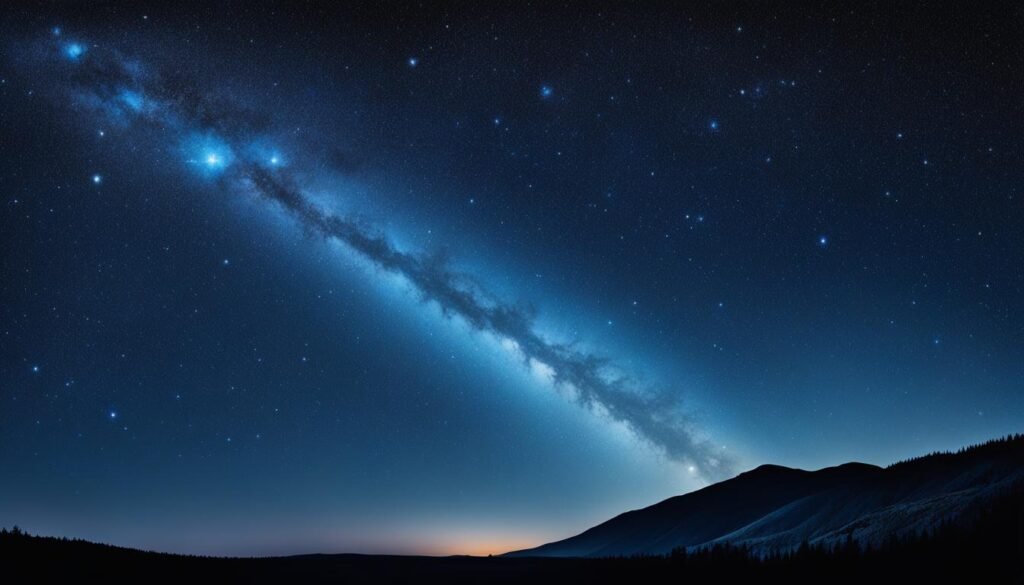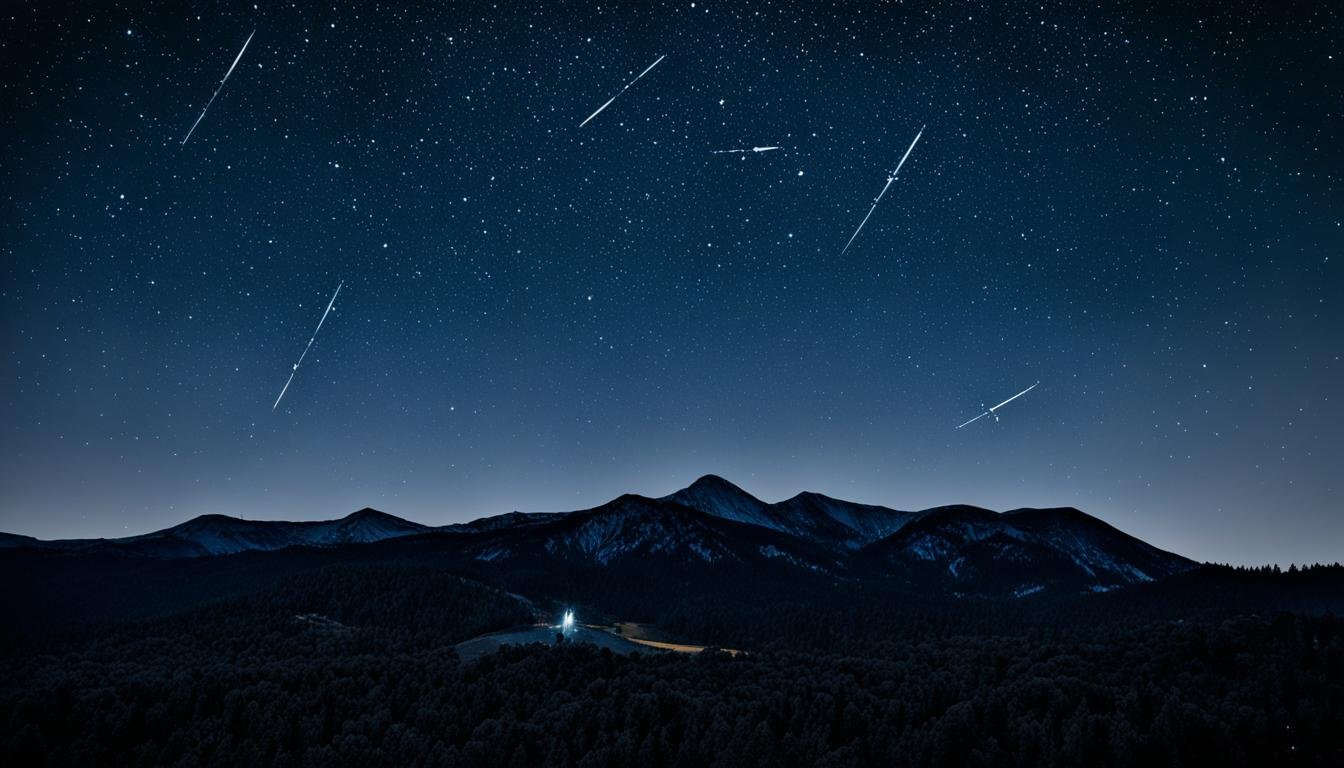When you gaze up at the night sky constellations, the orion constellation not only dominates the celestial stage with its prominent belt but also captivates with the stunning orions sword asterism. This fascinating alignment of celestial objects beckons skywatchers with its scintillating stars and cosmic curiosities. Located just below the three aligned stars known as Orion’s Belt, Orion’s Sword invites you to discover the treasures it holds, each component a narrative unto itself, scripting a tale as old as time within the canvas of the cosmos. As a central theme in asterism in astronomy, you’ll find that the wonders it encompasses are both a delight to the naked eye and a challenge to the astute observer.
Key Takeaways
- Orions sword asterism, located beneath Orion’s Belt, is a cluster of celestial objects that form a significant part of the orion constellation.
- The asterism includes various types of celestial wonders such as bright stars, nebulae, and star clusters, being a vibrant fixture in the night sky’s topography.
- Even in areas affected by light pollution, the asterism remains a discernible and striking feature, attributable to the high luminosity of its constituent celestial objects.
- Through the ages, Orion’s Sword has served as a reference point and source of wonder, illustrating the rich connection between humanity and the heavens.
- Engaging in the observation of Orion’s Sword offers a prime opportunity to appreciate the splendor and complexity of the night sky constellations.
Exploring the Stellar Wonders of Orion’s Sword Asterism
Orion’s Sword, a celestial treasure trove, invites you to unravel the mysteries written across the night sky. Looming beneath the easily recognizable Orion’s Belt, this asterism is a beacon for both budding and seasoned stargazers.
Unveiling the Celestial Components of the Sword
The allure of the Orion’s Sword Asterism lies in its rich assembly of stellar patterns and celestial objects. It boasts a collection of luminaries like 42 Orionis, Theta Orionis, and Iota Orionis, embedded within a cosmic canvas painted by the grandeur of the Orion Nebula. This diffuse nebula, visible as a smudge of celestial light, is a cradle for nascent stars.
A Glimpse into Orion’s Brilliant Nebulae and Star Clusters
The mesmerizing ensemble of Orion’s Sword includes the Running Man Nebula (NGC 1977), De Mairan’s Nebula (NGC 1982), and NGC 1980, a jewel often overlooked, dubbed as the Lost Jewel of Orion. Against the backdrop of this asterism, star clusters twinkle, bringing a sparkle to the eyes of beholders.
| Celestial Wonders | Description | Type |
|---|---|---|
| Orion Nebula (M42) | Stellar nursery visible to the naked eye | Diffuse Nebula |
| Theta Orionis | Heart of Orion, home to the Trapezium Cluster | Multiple Star System |
| Running Man Nebula (NGC 1977) | Showcases a vivid reflection nebula | Reflection Nebula |
| NGC 1980 | The ‘Lost Jewel’ at Orion’s Sword hilt | Star Cluster |
Theta Orionis: The Heart of the Dragon
At the constellation’s core resides Theta Orionis, the heartbeat of the asterism. This intricate cluster is a marvel, hosting the renowned Trapezium Cluster within the boundaries of the Orion Nebula Cluster. It serves as a cosmic lighthouse, with Theta1 Orionis C illuminating the mysteries of deep space, guiding your gaze to the wonders it holds.
Deciphering the Stellar Patterns of the Night Sky Constellations
As you gaze upward, you’ll find the night sky to be a vast canvas dotted with stars, among which are patterns that have guided humanity for millennia. An asterism, unlike its larger counterpart the constellation, is a subset that forms a recognizable shape and serves as a navigational beacon in the art of celestial navigation. Understanding the asterism definition helps you to grasp the essentials of reading the stars.
One such stellar pattern marking our celestial chart is the iconic Big Dipper, a part of Ursa Major, easily identified by its ladle-like shape. This asterism doubles as a compass, pointing skyward navigators to the North Star, Polaris. In contrast, the Winter Triangle, a trio of bright stars, captures the gaze during the colder months, comprising Betelgeuse, Sirius, and Procyon – cosmic beacons shining down on frosty nights.
With the season’s shift, the Summer Triangle emerges, formed by the stars Altair, Deneb, and Vega. This distinguished triad not only adorns the summer skies but also facilitates amateur stargazers in locating various surrounding celestial features. Recognizing these asterisms and their associated stars is crucial for both seasoned astronomers and casual night-sky observers alike.

The following table outlines notable asterisms and their primary components, aiding you in their identification:
| Asterism | Key Stars | Best Season for Viewing |
|---|---|---|
| Big Dipper | Alkaid, Mizar, Alioth, Megrez, Phecda, Merak, Dubhe | Spring |
| Winter Triangle | Betelgeuse (Orion), Sirius (Canis Major), Procyon (Canis Minor) | Winter |
| Summer Triangle | Altair (Aquila), Deneb (Cygnus), Vega (Lyra) | Summer |
Asterisms, therefore, are more than mere patterns; they hold the key to unlocking the mysteries of the cosmos. They not only contribute to the tapestry of the night but also to the fabric of our collective knowledge, connecting us all through the shared human experience of stargazing. So, the next time you set out under the vast night sky, remember these celestial landmarks, as they are your guide among the heavens.
The Historical Tapestry of Orion’s Sword Asterism
Delving into the annals of historical astronomy, you encounter the spectral legacy of the celestial hunter vividly illustrated in the Orion’s Belt asterism. This storied constellation has been a beacon for civilizations since antiquity, enshrined in the mythos and astronomy of ancient cultures. Orion’s magnificent three-star alignment, deftly etched into the heavens, offers more than just a guidepost for navigation; it serves as a cultural touchstone that has interconnected human narratives with the celestial saga.

Ancient Civilizations and Their Interpretations of Orion
The portrayal of Orion mythology mirrors a cosmic hunter, an archetype that gripped the imaginations of societies ranging from the Romans to the Aboriginal Australians. As such, the star clusters in mythology, namely those that compose Orion’s sword, have been variously identified across cultures, casting the celestial figure in various roles within their folklore and revered tales.
Mythology in Astronomy and the Celestial Hunter
Sail back through the channels of history and you’d find that Orion mythology was as rich and varied as the cultures that revered it. Reimagined as warriors and hunters, the constellation’s Latin sky descriptions, as provided by luminaries of ancient Rome astronomy, echo through modern nomenclature, bridging the chasm of time with an endearing narrative of the celestial hunter.
Latin and Arabic Contributions to Orion’s Story
Both ancient Rome and the erudite scholars of Arabic nations left an indelible mark on the lore of Orion’s Sword Asterism. Enlightening the world with their celestial codices, these historical custodians of the stars painstakingly documented the heavens, bequeathing the gift of their knowledge packed within the majestic arabic star names and profound Latin descriptions of the expansive sky above.
Guided Tour: How to Locate orions sword asterism in the Celestial Sphere
Discovering the wonders of the night sky begins with a journey to one of the most renowned celestial landmarks: Orion’s Sword Asterism. As part of your night sky guide, we will learn together how to spot and appreciate the stellar treasure that has captivated skywatchers for centuries. Whether you’re new to observing constellations or an experienced stargazer, these insights will enrich your understanding and enjoyment of the celestial hemisphere.
Spotting Orion’s Sword Amidst Surrounding Constellations
Orion’s Sword Asterism is nestled within the illustrious Orion constellation, a striking feature of the winter months astronomy. Poised below Orion’s Belt, the asterism is a beacon in the celestial navigation quest, flanked by Gemini, Taurus, and Monoceros. Skywatching tips to identify Orion’s Sword include locating the three aligned stars that form the belt, then scanning downwards to find the line of dimmer stars and nebulosity that signify the sword.
Best Practices for Skywatchers: Finding Orion’s Sword
Developing skills in celestial navigation enhances your stargazing experiences immensely. Start by becoming familiar with the equatorial constellation’s surroundings using sky charts or apps which plot right ascension and declination, bringing you closer to Orion’s Sword with ease. The best time to observe this asterism and its surrounding celestial marvels can greatly depend on your location, but with a bit of practice, you’ll soon be guiding others in this nightly voyage.
When the Celestial Sword is Most Prominent in the Night Sky
The most opportune moments for skywatching not only involve clear skies but also timing. For those in the Northern Hemisphere, the best time to observe Orion’s Sword is usually during the crisp clear evenings of the winter months, specifically around January at around 9 pm when Orion is high overhead. Conversely, in the Southern Hemisphere, it is the summer months that beckon stargazers to witness the asterism’s splendor. Setting a reminder for these peak times could lead to the most breathtaking observation sessions.
- Use this brief guide as a starting point to initiate your skywatching journey.
- Equip yourself with basic skywatching tips and a stargazing guide to gain confidence.
- Embrace celestial navigation and learn to read a star chart or use an app.
- Plan your observation for the best time to observe based on your hemisphere and local season.
- Remember, patience is key – the night sky reveals its secrets to those who wait.
Diving Deep into the Orion Nebula Within the Sword of Orion
Embark on a celestial journey to one of the most fascinating star formation regions in the night sky—the Orion Nebula, also known as Messier 42. Enclosed within this stellar nursery is a vast landscape, rich with the ingredients necessary for star development. Situated in the lively Sword of Orion, this nebula presents an astonishing glimpse into the origins of stars.
The Magnificent Expanse of the Great Orion Nebula
Revealed within the Sword of Orion, the Orion Nebula stands as a testament to the grandeur of our universe. This splendid formation is far more than a beautiful spectacle; it is also an enormous molecular cloud—home to an array of complex processes that give rise to new celestial bodies. As you look upon the bright vista, know that you are witnessing a corner of the cosmos where young star systems are taking shape amidst a vibrant reflection nebulae backdrop.
Trapezium Cluster: A Closer Look at the Cradle of Stars
Within the heart of the Orion Nebula, you’ll find the radiant Trapezium Cluster, a compact assembly of infant stars. These stellar entities contribute significantly to the embedded luminosity observed from Earth. Indeed, the Trapezium Cluster is an essential feature for understanding the mechanics behind the robust star-forming activities occurring within this region.
The Dynamic Complexity of Nebulae in Orion’s Sword
As you explore the Sword of Orion, you’ll encounter an array of diverse nebulae, each playing a role in the celestial ballet of life and light. De Mairan’s Nebula, for example, offers a site where newborn stars emerge from the molecular depths. Reflection nebulae mirror and scatter starlight, setting the stage for a remarkable phenomenon that captures the imagination and fuels the desire to unearth the secrets held within these interstellar clouds.
Combining the allure of the Orion Nebula, De Mairan’s Nebula, and other stellar bodies, the Sword of Orion is an outstanding reflection of the ongoing cycle that perpetuates throughout the cosmos. Below is a comparison of key elements that illustrate the dynamic nature and attributes of these star formation regions.
| Feature | Description | Significance |
|---|---|---|
| Orion Nebula (Messier 42) | Vast region of gas and dust, illuminated by the Trapezium Cluster | Primary site for research into star and planet formation |
| Trapezium Cluster | Group of young, massive stars within the Orion Nebula | Provides insights into the early stages of stellar development |
| Reflection Nebulae | Clouds of dust that reflect the light of nearby stars | Helps astronomers study the distribution of dust in star-forming regions |
| Molecular Cloud | Dense region of gas where stars are born | Contains the raw material for molecular and star formation |
| De Mairan’s Nebula | A region within the Orion complex associated with ongoing star birth | Offers a glimpse into the dynamic processes of stellar nursery areas |
As you delve deeper into the understanding of the Orion Nebula and its surrounding phenomena, you begin to appreciate the intricacy of the universe’s design—a place where chaos and harmony dance together in the creation of new worlds.
Astrophotography and Observing Tips for Enthusiasts
Embarking on the journey to capture the splendor of the night sky can be both exhilarating and challenging. With Orion’s Sword as your celestial muse, astrophotography allows you to preserve the night’s most magical moments. When it comes to capturing celestial objects, your approach needs to be as precise as the stars are distant. Mindful preparation and understanding the nuances of night sky photography are pivotal in creating truly stellar images.
Capturing the Sword’s Cosmic Beauty: Tips for Photographers
As you engage in the art of astrophotography, remember that targeting bright deep sky objects within Orion’s Sword requires patience and attention to detail. Your pursuit to photograph faint nebulae and star clusters will demand mastery over exposure settings, and here, practice plays a pivotal role. Utilizing night sky photography tips such as long exposures, low ISO settings, and a steady tripod will significantly improve your astrophotographic endeavors and enable you to illustrate the asterism’s sublime beauty.
Choosing the Right Equipment for Stargazing
The experience of stargazing is fundamentally amplified by the selection of appropriate astronomy gear. Telescope selection is critical: you’ll want a scope that not only brings distant stars into view but also offers clarity and stability. Equally, consistent performance of your stargazing equipment ensures that your night-time observations are both rewarding and inspiring. Whether your choice is a powerful refractor or a sizable reflector telescope, each will reveal different aspects of Orion’s Sword and its surrounding wonders.
Navigating Light Pollution to Gaze Upon Orion’s Sword
Light pollution in astronomy presents a significant hurdle, especially for urban stargazing. The glow of city lights often shrouds the finer details of constellations, making them elusive. But hope is not lost. Reducing skyglow by seeking out dark sky preserves or employing filters designed to block out artificial light will greatly enhance your view of the night sky. Even in less-than-ideal conditions, strategic planning and the use of modern technology can afford you a glorious view of Orion’s Sword, so you never miss the chance to witness the universe in its purest form.
FAQ
What is the Orion’s Sword Asterism and where is it located?
The Orion’s Sword Asterism is a notable pattern of stars and nebulae located just below the Orion’s Belt within the Orion constellation. It includes luminous stars, such as 42 Orionis, Theta Orionis, and Iota Orionis, as well as the Orion Nebula, the Running Man Nebula, and other celestial objects.
Can you explain what an asterism is in astronomy?
In astronomy, an asterism is a recognizable pattern or group of stars within a constellation. Unlike constellations, which have formal boundaries and are recognized by the International Astronomical Union, asterisms are informal and often comprise part of one or more constellations, like Orion’s Sword or the Big Dipper.
How does Orion’s Sword differ from Orion’s Belt?
Orion’s Sword is an asterism that includes a group of stars and nebulae located below Orion’s Belt, which is formed by three bright stars—Alnitak, Alnilam, and Mintaka—aligned in a row. Orion’s Belt is part of the larger Orion constellation, while Orion’s Sword is a component within the constellation that features a variety of celestial objects.
Who were some historical figures that contributed to our understanding of the Orion’s Sword Asterism?
Historical figures such as the Roman writers Cicero, Germanicus, and Gaius Julius Hyginus wrote about the stars and celestial patterns, including those in the Orion constellation. Arabic astronomers also made significant contributions to the study of Orion’s Sword Asterism and provided many of the star names we use today.
What is the best time to observe Orion’s Sword?
The best time to observe Orion’s Sword in the night sky is during the winter months for observers in the Northern Hemisphere, and during the summer for those in the Southern Hemisphere. Around the month of January, Orion’s Sword is typically at its highest point in the sky at about 9 pm, making it an excellent time for observation.
What celestial objects can be found within Orion’s Sword?
Orion’s Sword houses the Orion Nebula (M42), the Running Man Nebula (NGC 1977), star clusters like NGC 1981 and the Lost Jewel of Orion (NGC 1980), as well as the Theta Orionis cluster which includes the Trapezium Cluster at the heart of the Orion Nebula.
How does light pollution affect the visibility of Orion’s Sword and what can be done to mitigate its impact?
Light pollution can diminish the visibility of celestial objects, including those in Orion’s Sword. To mitigate its impact, observers can seek darker skies away from city lights, use pollution filters, and select nights with clear atmospheric conditions for stargazing.
What equipment is recommended for viewing the Orion’s Sword Asterism?
For the best experience in viewing Orion’s Sword, stargazers might use a telescope with sufficient magnification, a pair of binoculars, or rely on naked-eye observation. Different pieces of equipment will reveal varying levels of detail of the asterism’s celestial objects.
What tips do you have for photographing celestial objects like those in Orion’s Sword?
To photograph celestial objects within Orion’s Sword, one should use a camera with manual settings, including long exposure capabilities. A tripod is also vital to stabilize the camera for clear images, and utilizing a tracking mount can help to compensate for the Earth’s rotation.






